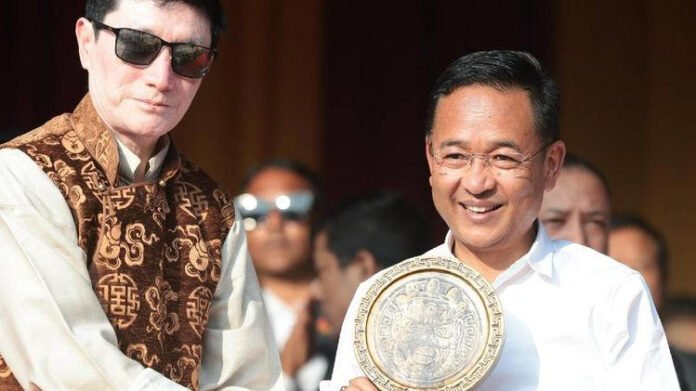The serene town of Rabong in South Sikkim came alive with colour, music, and tradition as Chief Minister Prem Singh Tamang joined hundreds of locals and visitors to celebrate the vibrant Cho-Dzo Festival, a culturally significant event for the region’s Buddhist community. The occasion, deeply rooted in heritage and spiritual symbolism, was also marked by renewed discussions on tourism promotion and sports development—two key pillars of Sikkim’s evolving growth story.
Organised with great fervour, the Cho-Dzo Festival is an annual celebration led by the Ralong Monastery, one of the most revered monasteries in Sikkim. The event features elaborate rituals, monastic dances, prayers for peace and prosperity, and serves as a vital platform for community bonding. The festival not only preserves ancient Buddhist customs but also attracts spiritual seekers and tourists, making it a cultural highlight in South Sikkim’s calendar.
Chief Minister Tamang, who participated in the festivities and addressed the gathering, lauded the local communities for upholding Sikkim’s rich traditions. He emphasized the government’s commitment to nurturing such heritage events, which, he noted, are essential not only for cultural continuity but also for driving economic opportunities through tourism.
The Chief Minister pointed out that Rabong, with its picturesque landscape, sacred sites, and spiritual legacy, holds enormous potential to become a leading destination for cultural and eco-tourism. He reiterated the state’s strategy to link traditional festivals like Cho-Dzo with broader tourism initiatives that benefit local artisans, hoteliers, transport operators, and youth.
In recent years, Sikkim has received national and international recognition for its clean, green, and organic identity. The government is leveraging this reputation by promoting responsible tourism models that emphasize cultural immersion, sustainability, and community participation. Festivals like Cho-Dzo are now being positioned as anchor points in curated tourism circuits, especially in South and West Sikkim.
During the event, the Chief Minister also spoke at length about sports infrastructure development, linking it to both youth engagement and tourism. Rabong and surrounding areas, he noted, have shown growing enthusiasm in adventure sports, trekking, and football, making them ideal for investment in grassroots sports facilities.
As part of the larger developmental blueprint, the government is set to roll out multi-purpose stadiums, trekking route upgrades, and skill development centres for athletes and youth entrepreneurs. Tamang highlighted that such initiatives not only channel youthful energy in constructive ways but also complement the tourism ecosystem by attracting sports enthusiasts and event organizers from across the region.
The Cho-Dzo Festival also featured exhibitions showcasing local crafts, traditional food stalls, and performances by folk artists, reflecting the cultural wealth of the Bhutia and Lepcha communities. Community-led stalls displayed products such as handwoven fabrics, organic produce, and religious artefacts—further enhancing the economic dimension of the festival.
Officials from the Departments of Tourism, Sports, and Culture were present at the celebration, holding consultations with local stakeholders about the infrastructural and promotional support required to expand Rabong’s visibility on the tourism map. These included discussions on improved homestay policies, better road connectivity, and the use of digital platforms for festival promotion.
Moreover, the presence of monks, community elders, youth groups, and visitors from other parts of the state lent the event a strong sense of unity and shared purpose. It underscored how tradition, when harmonized with development, can foster inclusive progress.
As the day concluded with the lighting of butter lamps and prayers for universal well-being, the Cho-Dzo Festival once again reaffirmed its position not only as a spiritual observance but also as a symbol of cultural resilience and developmental aspiration.
By celebrating such festivals with vision and vigor, Sikkim is crafting a narrative where heritage and modernity go hand in hand—ensuring that as the state grows, it does so with its roots deeply intact.




